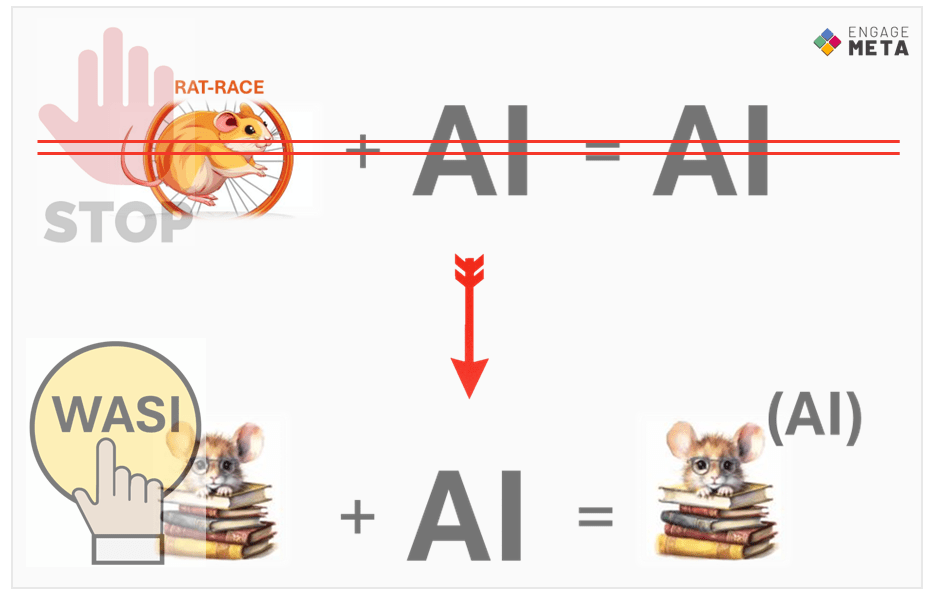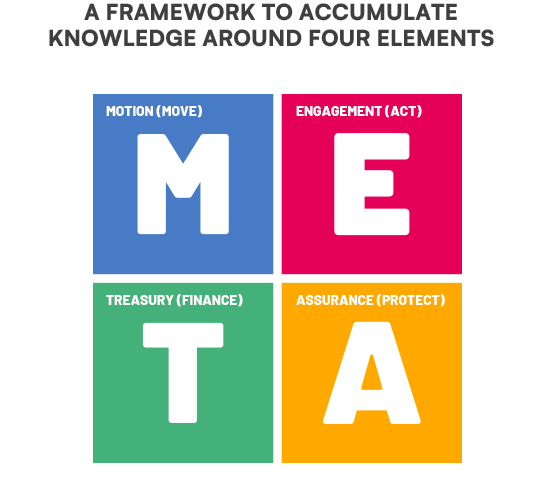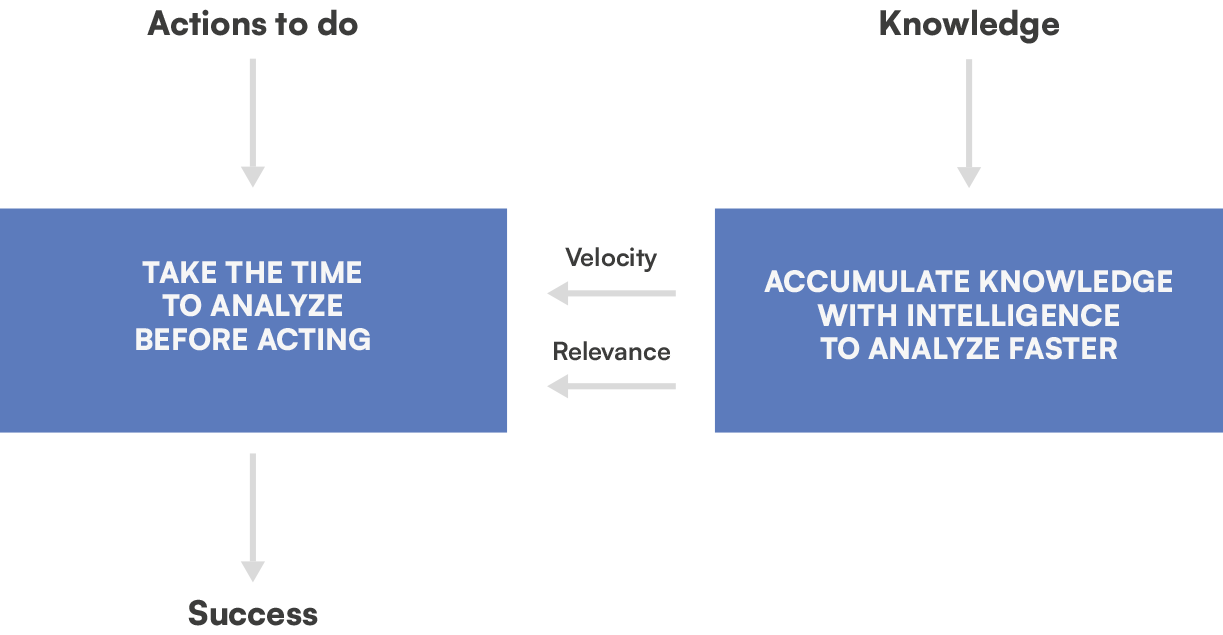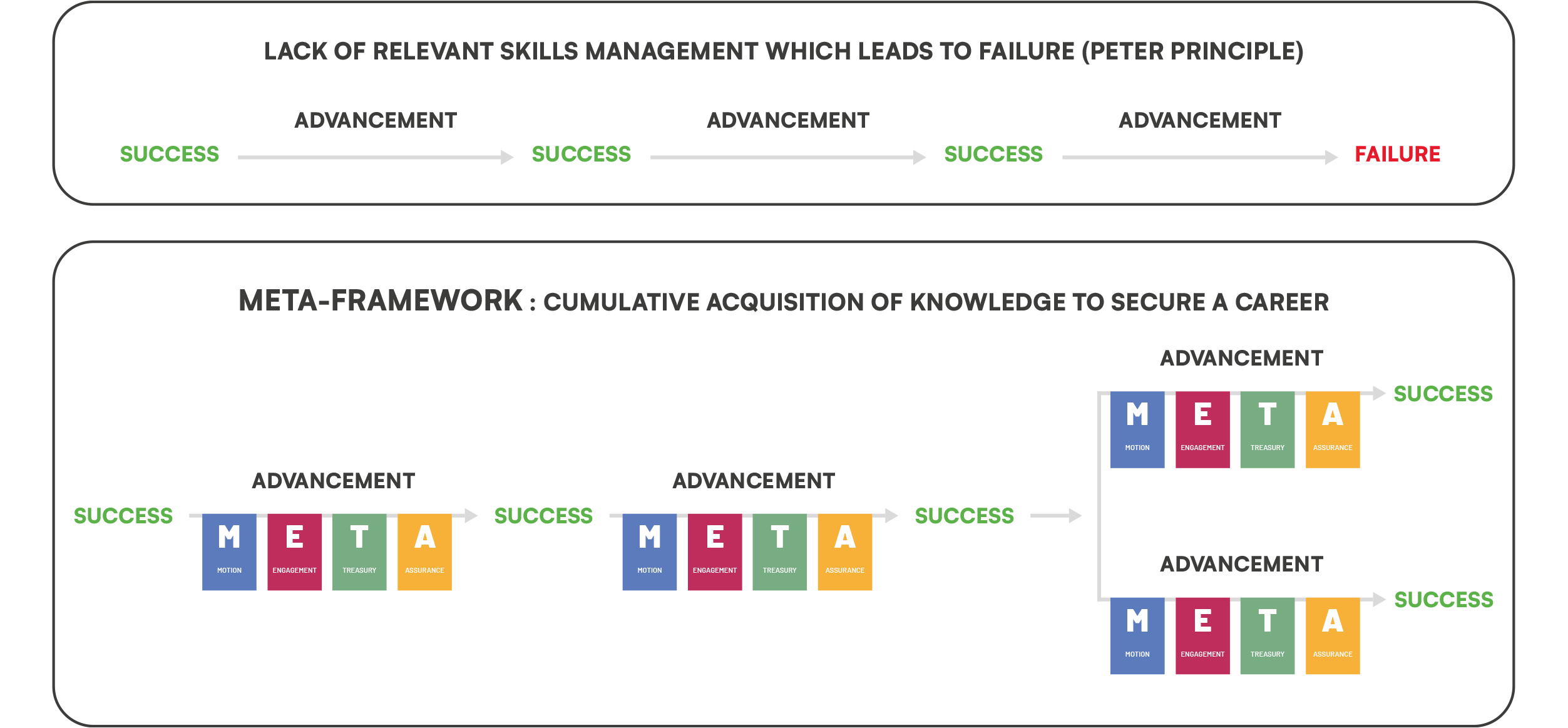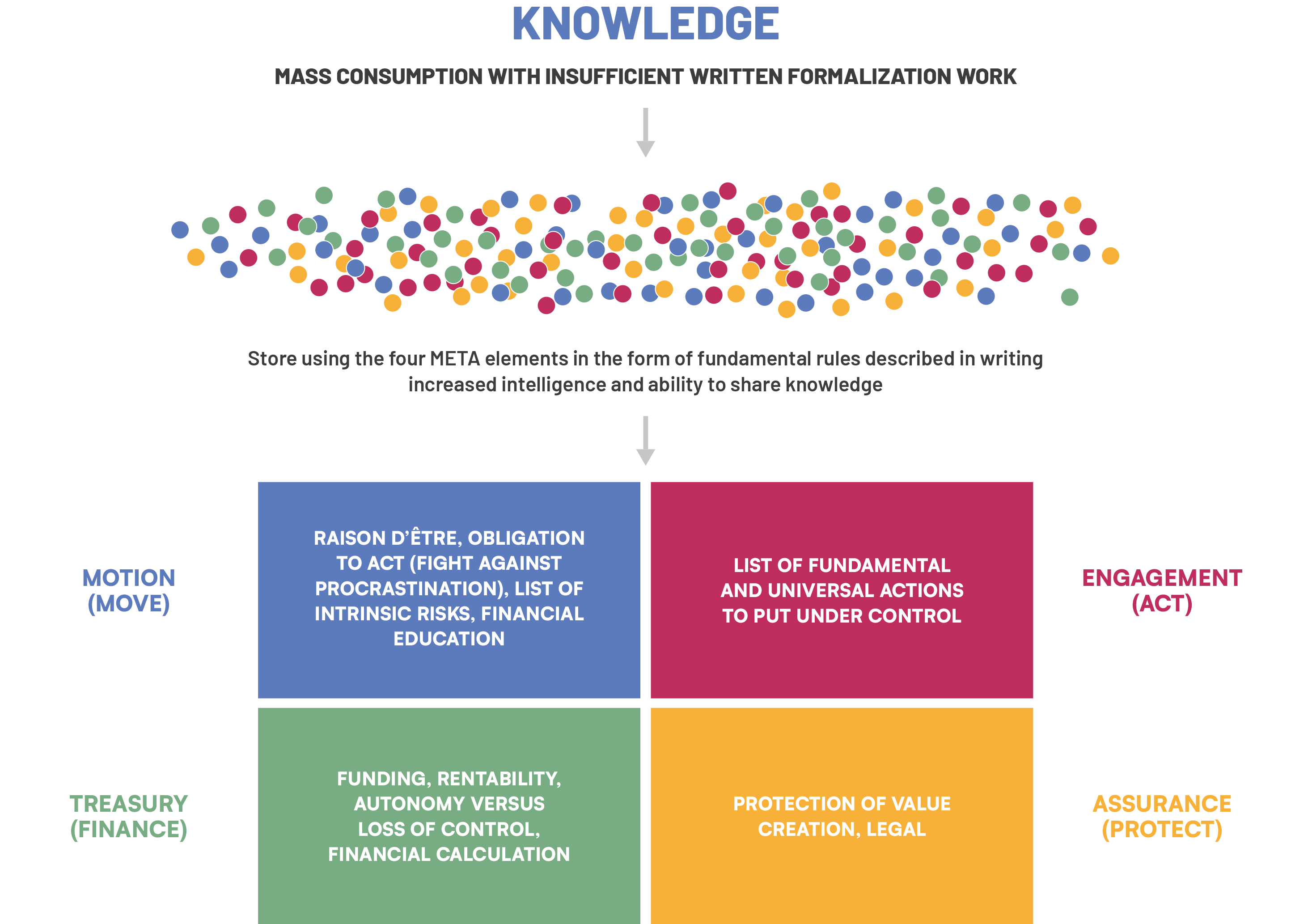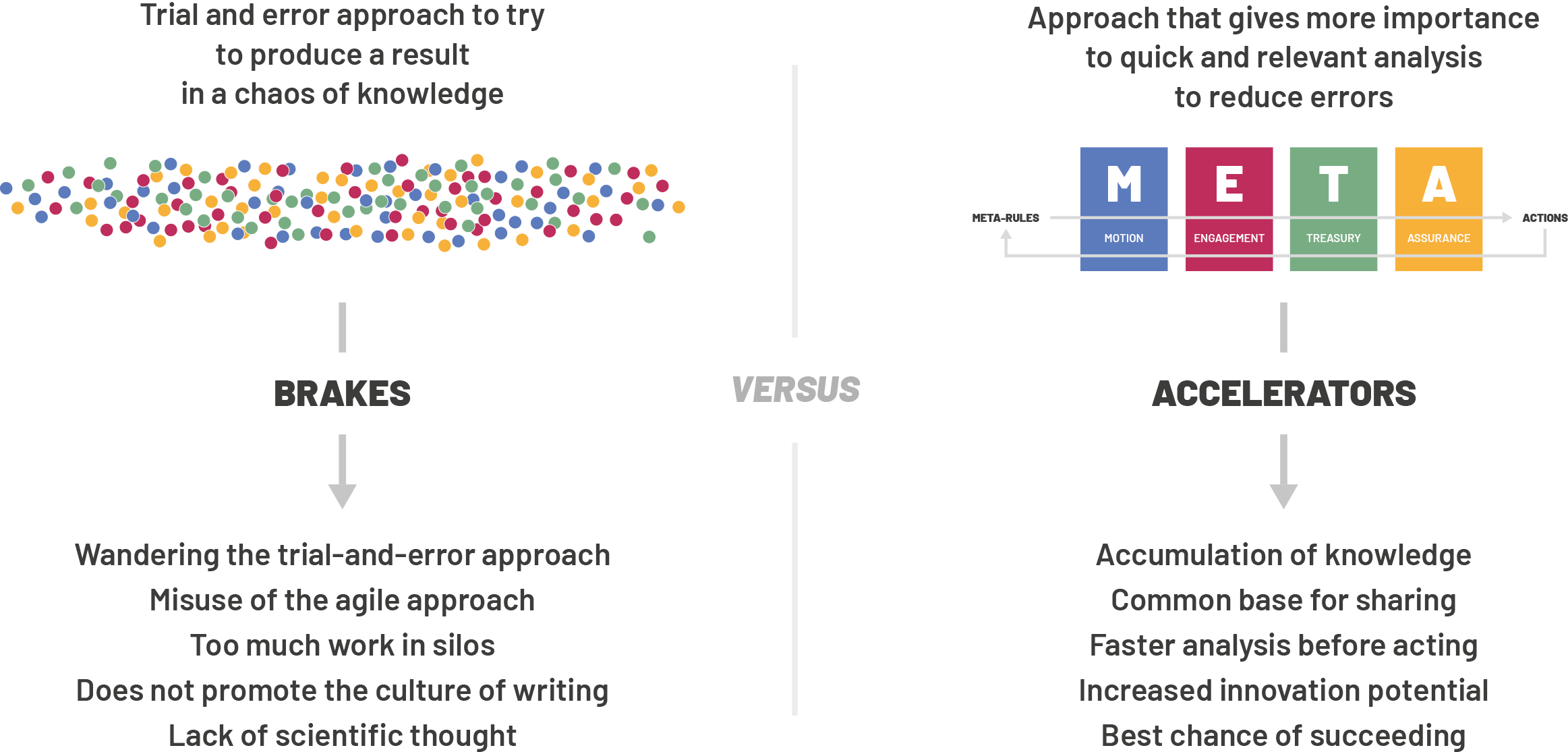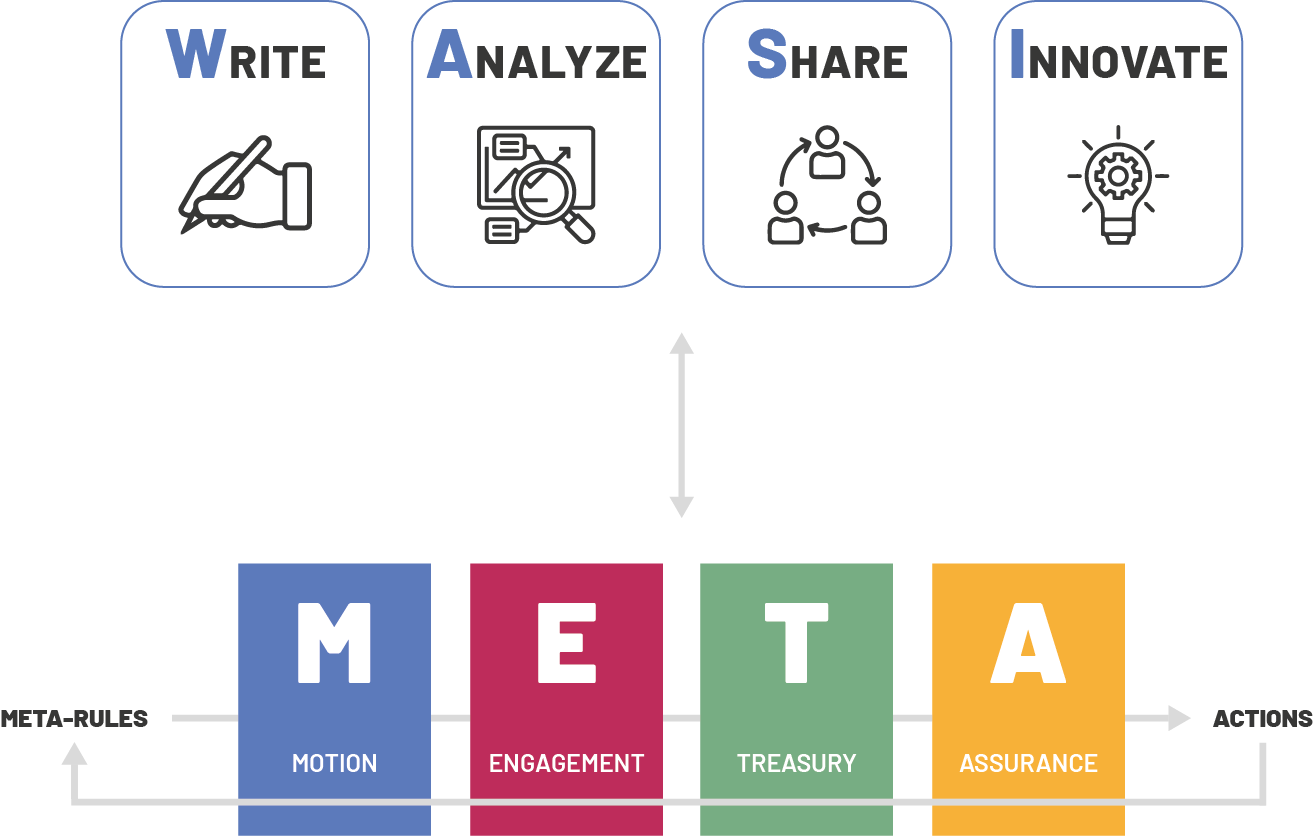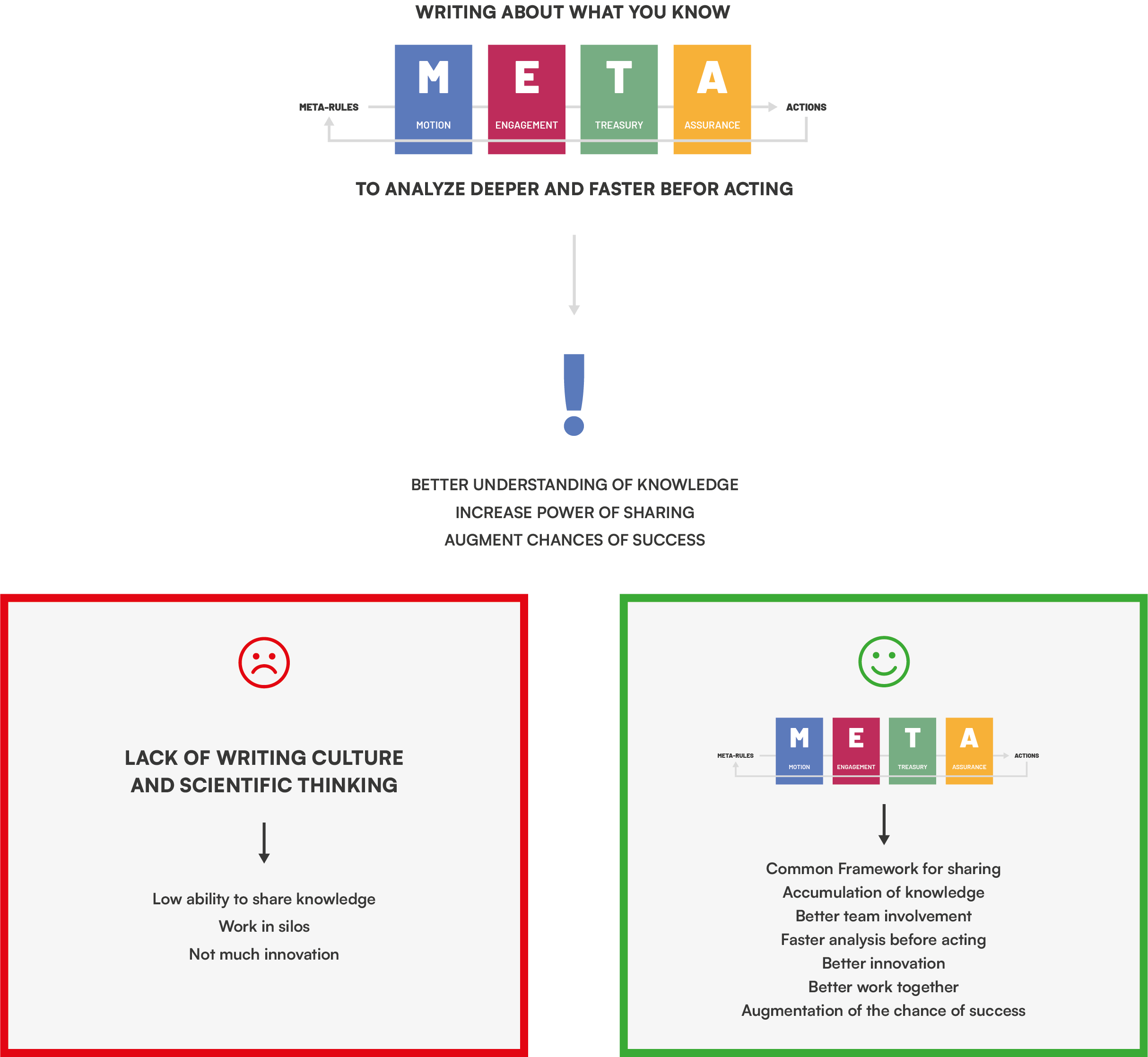AI KNOWLEDGE
accumulation
In this sphere, you will find practices that promote the transformation of tacit knowledge into explicit knowledge. This transformation is strategic for being able to train your AI systems with maximum value. It essentially involves documenting the know-how of your operators. This work represents a significant investment, but the return on investment, thanks to AI, is immediate. The more you formalize and accumulate knowledge over time, the more you can create AI assistants that are available on demand, as well as integrate them into your operational processes to enhance the overall performance of the company.
Knowledge management to power AI
In the company, only about 20% to 40% of knowledge is formalized in the form of databases and documents. The remaining 60% to 80% of knowledge remains trapped in the minds of employees. However, all this knowledge is necessary to train AI. Therefore, programs must be initiated to transform tacit knowledge into explicit knowledge and to improve the quality of these information reserves. They are strategic for the success of AI and for achieving the expected productivity gains.
Most of the time, the company lacks precise self-awareness. Documentation is scattered across different departments, databases contain only a small portion of the manipulated information, team turnover leads to losses in certain practices, and overall quality is unsatisfactory. However, in the realm of AI, all this knowledge is essential for training. Therefore, it is crucial to not only improve the quality of existing data management but also to extend this management to encompass all tacit knowledge.
Personal Knowledge: To level up AI, enhancing knowledge management systems to capture and organize explicit knowledge is crucial. This ensures that information is accessible and up-to-date. Simultaneously, tapping into the rich reservoir of individual tacit know-how can unlock innovative solutions and creative strategies. The motivation to convert personal tacit knowledge into explicit form is twofold: firstly, to assert human expertise in an era increasingly dominated by artificial intelligence, and secondly, to facilitate the systematic accumulation of knowledge. By articulating and sharing personal insights, individuals not only contribute to the collective intelligence but also provide valuable data and knowledge that can be used to train AI systems. This symbiotic relationship between personal knowledge and AI can lead to more sophisticated and intuitive technology that complements human capabilities, fostering a collaborative environment where both can thrive.
Collective Knowledge: Collective knowledge within an organization is a powerful asset, formed by aggregating the explicit and tacit knowledge of individuals within departments and across interdepartmental boundaries. The amalgamation of this knowledge is essential for enterprises, as it fosters innovation, efficiency, and competitive advantage. It is estimated that a significant percentage of an organization’s knowledge is tacit, residing in the minds of its employees, and remains unexploited. Accumulating this vast reservoir of implicit understanding is vital for organizational growth and adaptability. Artificial intelligence stands as both the conduit and the repository for this knowledge, capable of capturing, analyzing, and disseminating insights throughout the organization. AI systems help transform tacit knowledge into explicit knowledge, making it accessible and actionable, thereby solidifying the foundation of collective intelligence within an enterprise.
Enterprise Architecture: At the organizational level, cultivating a mindset that values and facilitates knowledge accumulation is paramount. Enterprise Architecture (EA) serves as the technical scaffold, enabling the scaling of knowledge from individual contributors to the organizational tapestry. Together, these elements not only empower AI integration within enterprises but also amplify its application and adoption, ensuring that AI solutions are both innovative and in sync with human expertise.
Soft skills are the bedrock of professional development, with critical thinking at the forefront. To bolster critical thinking, one must focus on enhancing writing skills for clear communication, honing analytical abilities to decipher complex issues, fostering innovation to navigate and create change, and promoting a culture of sharing to disseminate knowledge. In an AI-enabled enterprise, where human and AI co-work, critical thinking and writing skills are even more essential as they help achieve the best combination of human and machine intelligence. AI needs clear guidance and instruction from human co-workers to produce its best results, which are subsequently validated by humans (human-AI feedback loop).
In conclusion, mastering the art of writing, analyzing, sharing, and innovating is critical to harness the full potential of AI. Effective knowledge management, particularly the transformation of tacit knowledge into explicit knowledge, is essential for training AI and advancing organizational intelligence. This is the WASI effect. You can read more about the WASI effect HERE.
In this figure, you have an example of transforming tacit knowledge into explicit knowledge to enhance AI training. Here, the user is asked to formalize their knowledge on the critical use of a standard process described by the company, as well as to explain the use cases of this process in order to adapt it to real-world situations. All this written knowledge is then given to the AI to obtain a critical analysis of the standard process, thereby identifying areas for improvement. This principle of formalizing tacit knowledge can be repeated regularly (weekly, monthly, biannually, annually) to establish a continuous process improvement loop. Without AI, formalizing all this knowledge would be pointless as manual exploitation would be too costly. AI removes the barriers to knowledge accumulation, thus also promoting better practice sharing among participants, including new employees who need to be trained.
How to accumulate knowledge faster
In a complicated world characterized by deep digitalization and AI, we believe a holistic approach is necessary to foster the fastest knowledge accumulation. This approach is inspired by my career of more than 30 years as an intrapreneur, entrepreneur, and investor. I am Pierre Bonnet, founder of Engage-Meta. I have created a framework to formalize my experiences and knowledge called the META Framework. This is a very simple and basic framework designed to organize and enrich knowledge to accelerate value creation.
More precisely, I discovered two business rules that were essential for my success. I practiced them unconsciously, and it took me about 30 years to realize their importance. It was after the sale of my tech company at the end of 2018 that I took the time to uncover them. They may seem obvious, but applying them consistently is not simple because it requires rigor and discipline. This was the price to pay for my success. Let me share them with you now.
Take time to analyze
The quote from Eugene Alexandrovich Znosko-Borovsky illustrates this first rule that helps me succeed. This advice for chess is also relevant in business and project management.

It’s not a move, even the best move, that you must seek, but a realist plan.
Eugene Alexandrovich Znosko-Borovsky
However, this quote is not a common practice. Most of the time, entrepreneurs and project leaders are encouraged to try quickly without a lot of planning. Business plans are then seen as nonessential as it doesn’t matter if the plan is not feasible. Failure is not a problem and can serve as a lesson to do better next time. This “trial and error” approach leads stakeholders to repeat their failures and underestimate the value of analysis. Since most people dream of succeeding quickly and without much thought, they are no longer used to preparation and reflection. This lack of preparation does not facilitate success and conversely, a slow analysis would not work any better either. In reality, analysis does not paralyze action given it is done correctly. The secret to achieving this lies in the intelligent accumulation of knowledge rather than a fragmented absorption of information that limits the power of knowledge.
The trial-and-error approach is a very bad default option
This approach can succeed, but only with the condition that you can quickly leave the failure cycles to experience success before burning out. Unfortunately, I have observed that 99% of entrepreneurs and project leaders get stuck correcting their mistakes without ever getting out of the failing loop. This behavior is based on the illusion that anything that resembles intermediate result would lead to sustainable success. In reality, if this were necessary conditions for success, we would all be successful. It’s the same with agile methods in IT when they are misused. It is difficult to create a solid system by building one step immediately after another, without having taken the time to analyze the overall structure first.
With the trial-and-error approach, there is not enough time to do this. Even if we are aware of this weakness, it is still the go-to approach. By refusing to make some effort to analyze first and act immediately, the work seems simpler and the practice is reassuring. The entrepreneur and the project leader are satisfied to achieve something concrete, even if it results in failures again and again.
The trap of the trial-and-error approach lies in the survivorship bias
The one who comes out of this loop as a winner can easily explain all the failures he has gone through. The winner is happy to share this way of working since he finally achieved success, however, this is the representative of the 1% of whom it worked. The other 99% have followed the same approach, but all failed. These people rarely speak in public since who would be interested in learning about someone who has only experienced successive failures without ever succeeding? This leads to 99% of projects that probably fail because of poor preparation, which is a huge waste with consequences similar to this:
- An entrepreneur finds himself trapped in his business with no long-term perspective,
- An employee loses motivation because they lack understanding of their contribution to the company’s success,
- A digitalization project goes off course by losing sight of the goals,
- Data governance remains centralized which leads to integration problems with other departments in the company.
Accumulate knowledge
An analysis that is too long and without operational results is doomed to fail. 99% of entrepreneurs and project leaders do not know how to analyze in a quick and almost instinctive way. This quote from Arnold Schwarzenegger illustrates the idea of a fast analysis.
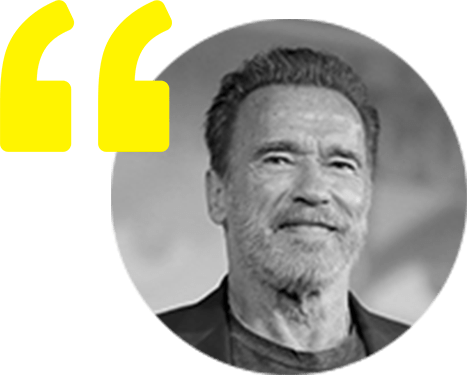
The more knowledge you have, the more you’re free to rely with your instincts.
Arnold Schwarzenegger
The progressive acquisition of knowledge feeds the analysis and allows it to be more rapid and reliable. With the Internet and Artificial Intelligence (ChatGPT), we have easy access to almost all knowledge, however, few people know how to exploit it to increase the chances of success. Most people consume knowledge, but do not process it properly, since they are satisfied with fragmented data which is not the full potential of knowledge. Only smalls parts of information are properly memorized for reuse, but there are no links between the different pieces of knowledge. In this case, knowledge stocks up in a disorganized manner and does not leave enough room for intelligence and sharing. Few people are able to build a mental map of their knowledge to accommodate more information in an intelligent way. Most just absorb data without processing it properly.
Take this quick knowledge test
Question: knowing that the planets are round, can you explain why? Many people do not have the answer. This king of hole in knowledge is common and the quality of knowledge is poor. It does not allow a reliable and fast analysis.
Answer: the reason for the shape of the planets is the impact of gravitational forces. It is then necessary to learn how gravity works. Thus, the intelligent accumulation of knowledge avoids fragmenting understanding.
This lack of control of knowledge is a barrier to get out of the trial-and-error loop I mentioned at the beginning. Indeed, to strengthen the analysis before acting, we need a firm grasp of knowledge. You have certainly seen brilliant decision makers who act quickly with virtually no mistakes. They do not play a guessing game, thinking they will learn from their failures through trial and error. They decide better and faster than others using knowledge accumulated intelligently.
Analyze + Accumulate
Reflecting on my 30-year career path, I realized how to organize all my most important knowledge into four elements that form the META framework: MOTION (Move), ENGAGEMENT (Act), TREASURY (Finance) and ASSURANCE (Protect). This structure is universal and it deals with the meta rules in an area of expertise or a project.
Regardless of your role (whether you’re an intrapreneur, entrepreneur, investor, athlete, artist, etc.) and the nature of your projects, you can organize your knowledge with the META framework. This framework assists you in accumulating crucial knowledge. Over time, it enables you to analyze more swiftly and saliently before taking action, thereby enhancing your chances of success.
If you are a manager, this knowledge management practice is also important for your employees for inclusivity and careers management. If you are an investor, you can increase the quality of your investments by instilling the META framework in your executive and operational teams. The META framework is based on a simple starting concept: storing the most important knowledge in the four elements. It is not useful to store all the subjects of knowledge in bulk, but rather to search deep within your knowledge for the rules that are most fundamental and universal. These are your meta-rules. By doing so, you build a tool to increase your chances of success, and also an effective communication tool to better involve your teams.
Write down your meta-rules

MOTION (Move)
Regardless of your field of expertise or your project, it is important to clarify your “raison d’être” in order not to lose sight on the journey to success. It involves being clear about the core values that motivate you to make the needed efforts over a long period of time to achieve success. For example, an entrepreneur uses his social background as a drive for success which is more concrete than a simple motivation. Or an athlete who is not satisfied with the mere pleasure of just performing his sport and sets himself an obligation to outperform. Regardless of his level of fitness, he will find the strength to train without procrastination or excuses.
If you struggle on a project, it could possibly be that your Motion is not strong enough.
You and your teams perhaps loose the sense of long-term action, which leads to a degradation of value creation. As I mentioned earlier, powerful and fast analysis relies on intelligent knowledge accumulation. This principle is difficult to maintain without a clear project’s values and an obligation to act.
With MOTION, you clarify your reasons for success and the DNA of your domain of expertise, which makes you strong. You then act with more harmony and tenacity, for yourself and your teams.

ENGAGEMENT (Act)
The META framework is not a recipe with steps and actions to follow in order to succeed. It would be difficult to describe and specify to certain contexts. In addition, luck is often a factor in success and it is not possible to take it into account in a method.
Thus, the objective is to identify only the fundamental and universal actions, whose poor execution could jeopardize your entire project or domain of expertise.
Fundamental actions are ones that do not tolerate any error and universal actions are independent on your specific context or on luck.
These are meta-rules that guide you towards success. They are also useful for your communication and knowledge sharing within your teams. The better your fundamental and universal actions are understood, the more the support you can receive.
Take time to strengthen your ENGAGEMENT by finding the fundamental and universal actions in the set of actions you need to take. Having a clear understanding of what is essential to do, you are sure of your acts.

TREASURY (Finance)
Money is usually the necessary condition for action, this is obvious in business, but also in project management in general. Depending on your level of responsibility, you will have to deal with the subject of financing yourself or with the collaboration of stakeholders such as your financial department or investors.
For an entrepreneur, the balance between personal financial need and professional profitability is not easy to manage. To achieve this equilibrium, it is not only a question of controlling the financial need, but also of valuing the financial rewards from your works in order to better manage the financial flows.
Therefore, a simple calculation of the return on investment is not sufficient to reveal the value of assets creation, it must be extended with assets valuation (intangible and tangible assets).
The objective is to establish a roadmap that balances the need for financing with a progressive assessment of the company or project. The stakes are high for entrepreneurs who want to keep control of their business instead of ceding it to investors.
In the case of a project or domain of expertise, the value analysis aligned with profitability thresholds should involve the decision-makers and business departments. You need to create an entrepreneurial spirit in your organization (intrapreneurship, interpreneurship). Project leaders must pay attention to value analysis and use it as a steering and communication tool.
By strengthening your TREASURY, you go beyond the calculation of a return on investment by taking into account assets valuation. The financing cycle is then adapted progressively to business growth.

ASSURANCE (Protect)
This element of the META Framework is about protecting your assets.
In business, the shareholders’ agreement and the share subscription contract describe the rules of operation between shareholders and investors. Without a good understanding of this element, the actors involved could take actions against the collective interest. In this case, conflicts can occur without a framework to facilitate their resolution. Often neglected at the time of the creation of the company or the start-up of a project, it is then too late to take an effective interest in it later on. The stronger the control of your Assurance on the first day of business, the less you risk impairment loss or even the failure of your project because of disagreements with your stakeholders. Similarly, the conditions for launching a process to sell the business must be specified early enough in the value creation cycle. Without anticipating this, the entrepreneur runs the risk of being trapped in the capital of his company without any hope of adding value to it and exiting in a winning manner.
Your ASSURANCE is carefully described for projects or domain of expertise in a similar way to that explained for entrepreneurship. It is then necessary to specify in writing the governance with the rules of conflict resolution, and the protection of the assets that belong to and are created by the project.
By setting up your ASSURANCE at the creation of your company or at the start of your project and domain of expertise, you avoid the risk of value destruction.
Career management
The framework serves as a protection against the “Peter Principle” trap that pushes you along a career until a point of incompetence without even realizing it. With the META framework, the work of formalizing and accumulating knowledge enable you to better control this risk.
Fragmented knowledge
In a world where knowledge is consumed massively in a fragmented way, the lack of formalization of knowledge in writing is a hindrance to success. META framework is a good way to organize in this pool of knowledge in order to better exploit it. It is also important to keep control of intelligence artificial by writing relevant prompts.
Attitude at work
The individual or organization that uses META framework reduces the use of the trial-and-error approach in favor of a greater formalization of knowledge in order to accelerate analysis.
This approach adapts better to a world that is changing under the effect of hyper-knowledge brought about by digitalization, big data and artificial intelligence.
To achieve this, the individual or the organization must improve on these indispensable qualities: the culture of formalization in writing to capitalize on fundamental knowledge, the taste for rapid and relevant analysis, and the desire to share and innovate: this is the WASI process (Write, Analyze, Share and Innovate).
Finally, the META framework is akin to scientific thinking to increase your chances of succeeding in a complex world, by adopting better knowledge management over time.
The symbolism
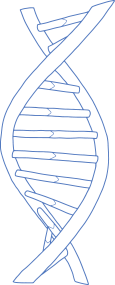
MOTION (Move) - Biology
To clarify the purpose of the activity or knowledge area.
It is about exposing its DNA. The symbol of the molecule that carries the hereditary genetic information is used. Each strand of DNA corresponds to a fundamental and universal rule contained in the element Motion.
The color blue symbolizes reliability and truth. It expresses the solidity of the Motion element in order to find the values and the raison d’être of your project deep inside yourself.

ENGAGEMENT (Act) - Physics
To illuminate the starting line to success, thanks to the DNA of Motion.
This first light is the original beam that enters the prism of Engagement. It then breaks down into as many new beams as there are fundamental and universal rules to follow in order to succeed. The symbol of the prism is therefore used.
The color red represents power and energy. It symbolizes the strength of the Engagement element to take action in a positive and sustainable way.
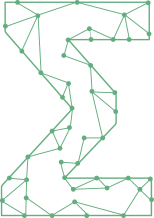
TREASURY (Finance) - Mathematics
To discuss the financing plan and the calculations of assets’ valuation.
The sign is structured with internal segments to establish its strength. They represent the fundamental and universal rules that form the content of the Treasury element.
The green color represents the financial dimension. It symbolizes the contribution of the Treasury element to synchronize the financing cycle with the sustainable growth of the business over the long term.
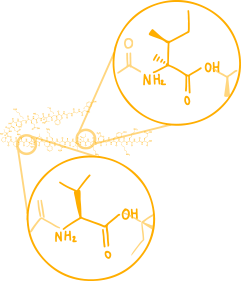
ASSURANCE (Protect) - Chemistry
To address the legal protection and governance of the domain and assets.
It is akin to practicing a high intensity physical activity. The effort is hard and may hurt, but afterwards the body and mind feel better. In other words, the field of knowledge is strengthened by the element Assurance. The chemical symbol used is a part of that of endorphin, which is the pleasure hormone produced especially during intense physical activity. The acid amine as parts of endorphin: valine (below) and isoleucine (above) are retained. They represent respectively the rules of governance between stakeholders and the rules of asset protection.
The orange color illustrates the ambition to succeed. It represents the rules of the Assurance element to protect the business from its inception and throughout its growth.
With the use of the META framework to collect, store and share knowledge, I invite you to leverage this same color coding. To present information related to protecting your business, you would use the color orange, then green for the financial and valuation aspects, red for the fundamental and universal actions, and finally blue for the values and the reason for your commitment.


